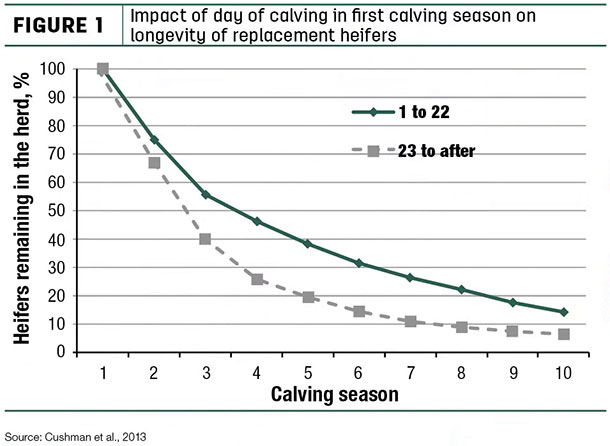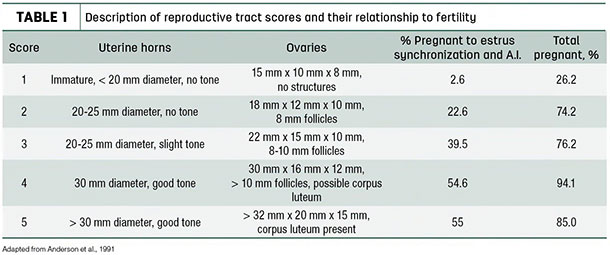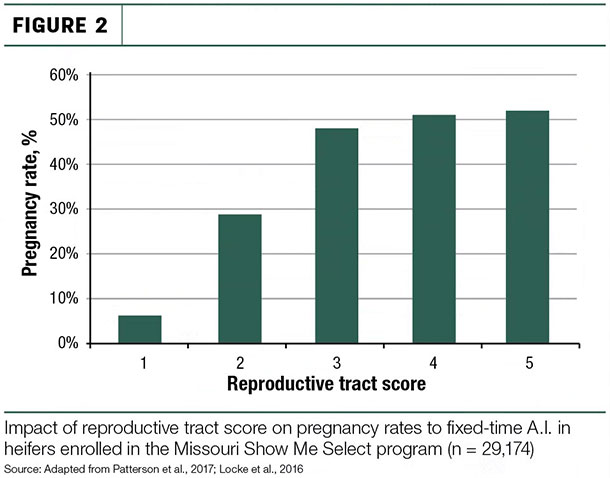Increasingly, there are more tools for heifer selection including genomic testing and EPDs for reproductive traits. However, heifer fertility is still a difficult trait to evaluate.
Heifer fertility has a major impact on lifelong cow productivity and longevity. Heifers that become pregnant in the first 21 days of the breeding season stay in the herd longer (Figure 1) and produce more pounds of beef in their lifetime.

So limiting heifers to a 30- or 45-day breeding season and only retaining those heifers that breed in the first 21 to 30 days is an effective method for improving heifer fertility and cow longevity. While early conception identifies fertile individuals, it does so after the breeding season.
Currently, heifer pre-breeding exams are the best tool available to evaluate fertility in beef heifers. Reproductive evaluations give an indication of proper growth and development as well as potential heifer fertility. In addition, a pre-breeding exam can eliminate heifers that have a high potential for calving problems.
A complete heifer reproductive exam or information should include:
- Evaluation for structural correctness
- Bodyweight and body condition score (BCS)
- Reproductive tract score (RTS)
- Pelvic area measurement (PA)
Bodyweight and body condition score
The most important factors affecting reproductive performance in heifers are bodyweight and body condition. Many other measurements such as RTS and pelvic area are related to bodyweight. Heifers should weigh 55 to 65 percent of their mature weight at breeding and 85 to 90 percent of their mature weight at calving.
At all critical times, heifers should be BCS 6 or 7. By reaching these bodyweights and condition, nutrition will not limit conception, calving ease and rebreeding.
Reproductive tract scores
Reproductive tract scores are taken at 13 to 14 months of age, immediately before the start of the breeding season. Heifers are palpated and given a score from 1 to 5. A score of 1 indicates an infantile reproductive tract, whereas a score of 4 or 5 indicates that the heifer is already cycling.
Reproductive tract scoring will identify infertile or sub-fertile heifers that should be culled. It is an especially important procedure to perform on heifers of unknown origin, heifers that may have been implanted and heifers that are to be sold as open heifers for breeding. However, it provides an effective method for evaluating home-raised heifers as well.
Even though RTS is highly related to bodyweight and age, heifers still need an RTS because even big, fast-growing heifers can be infertile. Heifers that score a 4 or 5 will have higher pregnancy rates than heifers that score lower (Table 1).

Heifers that score a 1 should not be retained for breeding, as they are infertile. Heifers that score 2 may be kept for breeding, but will probably breed late in the breeding season. Heifers with a high RTS breed back sooner as first-calf heifers.
The original work on reproductive tract scores summarized in Table 1 used only prostaglandin to synchronize heifers. It has been suggested that when the estrus synchronization method used contains progesterone (melengestrol acetate [MGA]) or a controlled intervaginal drug release device (CIDR), that RTS 3 heifers might perform similarly to RTS 4 and 5 because these RTS 3 heifers will be induced to cycle by the synchronization protocol.
Recently, a study from the University of Missouri (UM) and a study from Washington State University (WSU) examined the effect of RTS on pregnancy rates to fixed-timed A.I. (FTAI) systems that used progestins. The WSU study also compared heifers bred by natural service to those bred by FTAI.
The UM study examined the pregnancy rate to FTAI in over 29,000 heifers enrolled in the Missouri Show-Me Select Heifer program. Their results indicated that RTS 1 and 2 heifers were poor candidates for FTAI (Figure 2).

While RTS 3 heifers responded adequately to the FTAI protocols and became pregnant, RTS 3 heifer pregnancy rates were still 4 percent lower that RTS 4 or 5.
In agreement with the UM study, heifers with greater RTS had higher FTAI pregnancy rates in the WSU study. However, A.I. pregnancy rates were 16 percent lower for RTS 3 heifers compared to RTS 5 heifers. Even RTS 4 heifers had a 7 percent reduction pregnancy rate to FTAI. Pregnancy rates for the entire breeding season were 6 to 9 percent lower in heifers with RTS 3 compared to RTS 5.
Together, these studies indicate that RTS 3 heifers will have adequate pregnancy rates during the breeding season either with or without FTAI. However, RTS heifers are less fertile than RTS 5 heifers.
High reproductive tract scores are no guarantee all heifers will get pregnant. Remember, pregnancy rates of 85 to 95 percent are the biological norm. So about one in 10 or one in 15 heifers will be open at the end of the breeding season. If over 90 to 92 percent of your heifers get pregnant in a 30- to 45-day breeding season, then heifer fertility is considered excellent.
Antral follicle counts
Recently, research indicates a correlation between high antral follicle counts and fertility in beef cattle. Antral follicles are structures on the ovary that have the potential to become recruited and develop into follicles that produce a fertile egg. During the estrous cycle, many of these follicles fail to develop.
However, heifers with greater antral follicle numbers appear to have greater fertility and longevity. Antral follicles over 3 millimeters can be counted by a highly trained technician or veterinarian using ultrasound. At this point, antral follicle counts are not part of a typical heifer pre-breeding exam. However in the future, this technique may improve our ability to select fertile heifers.
Pelvic area measurement (PA)
Pelvic area of a heifer at calving will dictate the size of calf she can deliver. Extensive research from Nebraska and Montana indicates that a maximum deliverable calf weight can be predicted from pelvic area measurements taken at either 12 to 14 months of age (pre-breeding) or 18 months of age (pregnancy exam).
However, pelvic areas are of little use if the birthweight of the calf can not be controlled or predicted. In addition, selecting heifers with larger pelvic areas result in retaining heifers with a larger overall frame size.
Pelvic areas should be used as a culling tool, not a selection tool. Research indicates that heifers with PA smaller than 140 square centimeters pre-breeding or 180 square centimeters at pregnancy exam have a high percentage of calving difficulty. I recommend heifers with pelvic areas of less than 150 square centimeters (pre-breeding) or less than 190 to 200 square centimeters (preg. check) not be kept.
Heifer pre-breeding evaluations can be combined with pre-breeding vaccinations or conducted at the beginning of estrus synchronization. A skilled veterinarian or technician can evaluate 200 to 400 heifers a day. Usually these exams cost only a few dollars per head and eliminating the 5 to 10 percent of heifers that do not pass exams can easily pay for the procedure. ![]()
PHOTO: Heifers should weigh 55 to 65 percent of their mature weight at breeding and 85 to 90 percent of their mature weight at calving. Staff photo.
References omitted but are available upon request. Click here to email an editor.

-
John B. Hall
- Extension Beef Cattle Specialist
- University of Idaho
- Email John B. Hall








